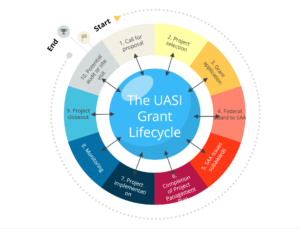The Urban Area Security Initiative (UASI) grant lifecycle is the ten-stage process that UASI grants in the National Capital Region (NCR) go through from beginning to end.
Each year, the Department of Homeland Security (DHS) awards UASI grants to enhance regional preparedness, and build capabilities in 31 high-threat, high-density urban areas. DHS awards these grants to State Administrative Agencies (SAAs) to administer and provide funds to localities and other eligible subrecipients to implement grant program objectives. The SAAs have a 3-year period of performance to complete UASI grant projects. Subrecipients of the SAAs are provided much shorter periods due to the time required to carry out the many grant lifecycle phases from application to closeout period. The District of Columbia Homeland Security and Emergency Management Agency (DCHSEMA) is the SAA that issues UASI subawards to the NCR, which includes the Maryland-National Capital Region Emergency Response System (MDERS). DCHSEMA provides its subrecipients an 18-month period of performance to carry out their projects, with occasional extensions for unique circumstances.
Since its inception, MDERS has become the single point of coordination for response partners across Montgomery and Prince George’s Counties. The Maryland Institute for Emergency Medical Services Systems (MIEMSS) is the sponsoring agency of the MDERS program. Agencies within the counties receive funds to purchase equipment and supplies that will be used for their organization’s emergency response capabilities. UASI is a reimbursement grant; therefore, MIEMSS and the counties fund the initial purchases, and are later reimbursed by DCHSEMA. MDERS is often working on four grant years at once: one in the planning stage, two open grant years, and one in the close-out process.
Lifecycle Stages

The stages of the Grant Lifecycle for NCR UASI grants are as follows:
- Call for Proposal (January, Year 1) – The Homeland Security Executive Committee (HSEC) invites proposals from government and other eligible organizations within the NCR. Proposals must adhere to the criteria laid out in HSEC’s Regional Guidance, including linking to priority capability objectives, having a clear nexus to terrorism, and benefitting operational areas.
- Project Selection (April, Year 1) – After careful consideration, the HSEC selects projects that align with the criteria and will advance regional priorities by focusing resources to address risks.
- Grant application (May, Year 1) – DCHSEMA completes DHS’ regional grant application, demonstrating how proposed projects address gaps and deficiencies in current capabilities.
- Federal Award to SAA (July – September, Year 1) – Upon completion of the application review process, DHS awards UASI funds to the SAA based on risk and the anticipated effectiveness of the proposed use of grant funds.
- SAA issues Subawards (October, Year 1) – The SAA issues subaward letters. Once they are signed by all parties, the period of performance begins for the subrecipients. The period of performance is generally an 18-month period in which the project must be completed. Occasional extensions may be granted depending on the status of the project.
- Completion of Project Management Plan (PMP) (October, Year 1) – Subrecipients must complete or update the PMP for each award, as per the requirements of the SAA.
- Project Implementation (Approx. 18 months: November, Year 1 – May, Year 3) – Subrecipients implement their projects as per the approved PMPs, while following the terms and conditions of the subawards, and all applicable federal and local laws, policies, and procedures. Subrecipients should submit reimbursement requests to the SAA as the goods and/or services are paid.
- Monitoring – The SAA conducts monitoring throughout the grant’s period of performance by requiring Quarterly Status Reports (QSRs), which include updates on programmatic and spending progress. Additionally, DHS and the SAA have the right to make site visits to monitor and review project accomplishments and to provide any required technical assistance.
- Project Closeout (June – August, Year 3) – Subrecipients must meet all project closeout reporting requirements as per the terms and conditions of the grant award, including submitting final QSRs, and providing proof of deliverables, Equipment Purchases form, and all reimbursement requests are due no later than 30 days after the end of the performance period.
- Audit or Site Visit – Both external and internal audits or site visits could potentially take place after the project is closed out. It is vital that the subrecipient maintains subaward files that contain complete and up-to-date records. These files may be paper or electronic, if they are easily and quickly accessible and available for review.


